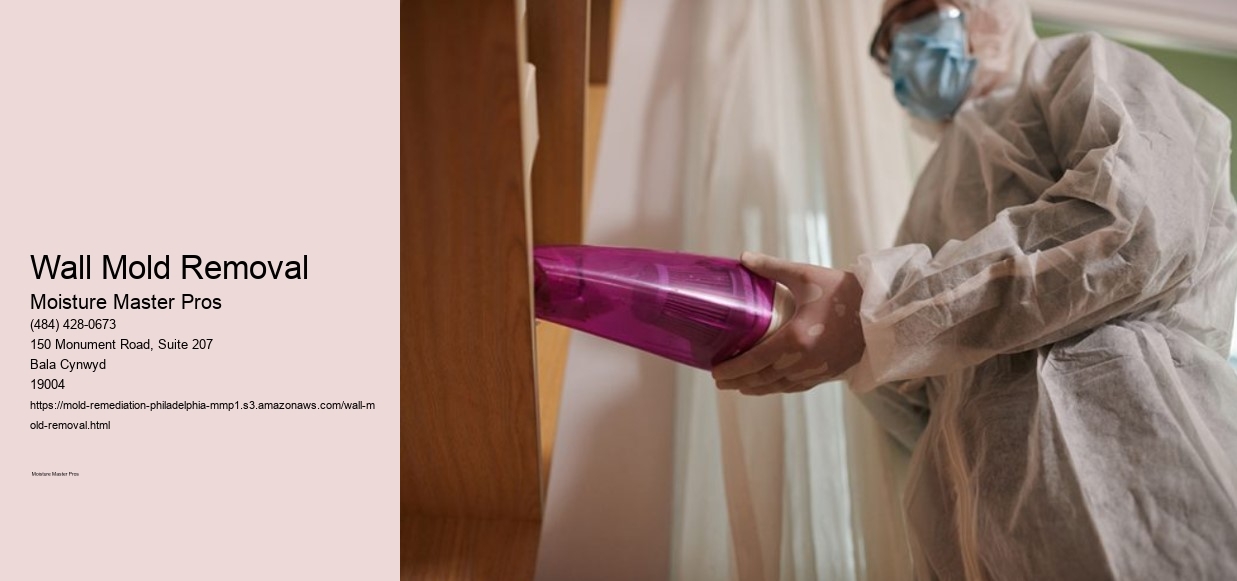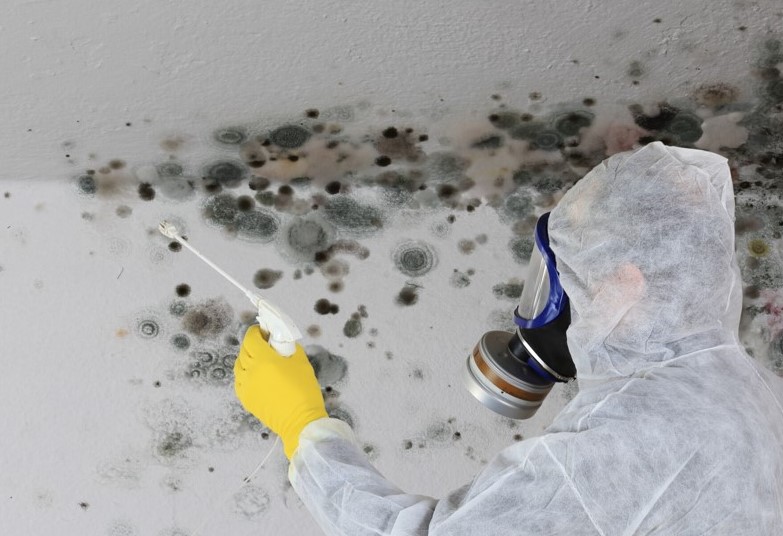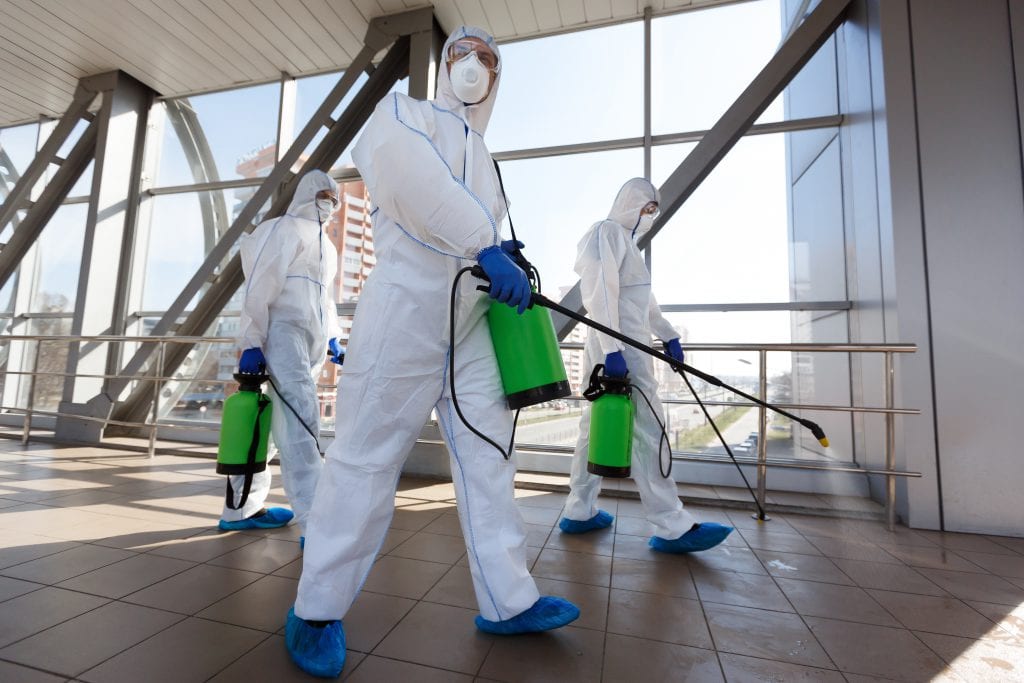

Mold Remediation Process
Initial Assessment
A thorough assessment is conducted to identify the extent of mold infestation and the source of moisture. This helps in creating a detailed remediation plan.
Containment and Air Filtration
Containment measures, including air filtration, are implemented to prevent mold spores from spreading during the remediation process.
Removing Mold-Infested Materials
In some cases, materials like drywall or carpeting that are infested with mold may need to be removed and replaced to ensure complete eradication.
Cleaning and Disinfection
Like removal, remediation includes cleaning and disinfecting all affected areas to eliminate mold spores.
Preventative Measures
Preventative steps, such as improving ventilation and repairing leaks, are taken to address the root cause and prevent future mold growth.
Choosing Between Mold Removal and Remediation
Severity of the Mold Problem
The decision between removal and remediation often depends on the severity of the mold problem. Read about the best Wall Mold Removal. Moisture control For minor issues, removal might be sufficient, but for more extensive growth, remediation is necessary.
Long-Term Solutions
For long-term peace of mind and a healthier environment, mold remediation is usually the better choice as it prevents future problems by addressing the root cause.
Conclusion
Recap of Key Points
Understanding the difference between mold removal and remediation is crucial. While removal is a surface-level solution, remediation provides a comprehensive approach to tackle mold and prevent its return.
Final Thoughts
When dealing with mold, consider the severity and the potential health risks. Opting for mold remediation ensures a thorough and lasting solution, keeping your home or business safe and healthy.
Mold problems can be daunting, but with the right approach, you can ensure your space is mold-free and safe for everyone.
The Role of Thermal Imaging in Effective Mold Remediation
Introduction to Mold Remediation
Mold remediation is crucial for maintaining a healthy living environment, but traditional methods of mold detection can sometimes fall short. Here, we'll explore how thermal imaging has revolutionized mold remediation by making the detection process more accurate and efficient.
What is Mold Remediation?
Mold remediation involves identifying, cleaning, and removing mold from an indoor environment. It’s essential for preventing health issues and structural damage. Mold can grow in damp, humid areas, often hidden behind walls, under floors, and in ceilings.
Common Causes of Mold Growth
Mold thrives in moist environments. Common causes include water leaks, high humidity, poor ventilation, and flooding. Identifying these sources is crucial for effective remediation.
Traditional Mold Detection Methods
Traditionally, mold detection has relied on visual inspection and air quality testing. These methods can be effective but often miss hidden mold growth. This is where thermal imaging steps in as a game-changer.
Introduction to Thermal Imaging
What is Thermal Imaging?
Thermal imaging is a technique that uses infrared technology to detect heat patterns. It captures temperature variations in objects, which can reveal hidden issues such as moisture behind walls, a common precursor to mold growth.
How Thermal Imaging Works
Thermal imaging cameras detect infrared radiation (heat) and convert it into an electronic signal. This signal is then processed to produce a thermal image, highlighting temperature variations in different colors. Cooler areas often indicate moisture, a key factor in mold growth.
Benefits of Using Thermal Imaging in Mold Remediation
Accurate Detection
One of the biggest advantages of thermal imaging is its accuracy. It can pinpoint hidden mold that’s not visible to the naked eye, ensuring no area is overlooked during remediation.
Non-Invasive Method
Unlike traditional methods that might require invasive procedures like cutting into walls, thermal imaging is non-invasive.
Time and Cost Efficiency
Thermal imaging speeds up the detection process and reduces labor costs by quickly identifying problem areas. This efficiency translates into cost savings for homeowners and businesses.
Enhanced Documentation
Thermal imaging provides visual documentation of mold-affected areas. These images can be used in reports and insurance claims, offering clear evidence of the extent of mold contamination and the necessity for remediation.
Steps Involved in Thermal Imaging for Mold Detection
Initial Assessment
The process begins with an initial assessment to identify areas likely to have moisture problems. This step involves discussing any known issues with the property owner and performing a preliminary inspection.
Conducting the Thermal Imaging Scan
A certified technician uses a thermal imaging camera to scan the suspected areas. The camera captures temperature variations, highlighting potential moisture spots in different colors on the screen.
Analyzing the Results
The thermal images are analyzed to identify patterns indicative of moisture and potential mold growth. Cooler spots on the images often signify moisture-laden areas, which are prime locations for mold.
Confirmatory Testing
While thermal imaging is highly effective, confirmatory testing, such as moisture meters or air sampling, is often used to verify the presence of mold. This step ensures the accuracy of the findings.
Case Studies and Real-Life Applications
Residential Mold Remediation
In homes, thermal imaging has proven invaluable. For instance, it can identify leaks behind walls and under floors that would otherwise go unnoticed until significant mold growth occurs.
Commercial Building Applications
Commercial buildings, with their complex structures and vast areas, benefit greatly from thermal imaging. It allows for comprehensive inspections without disrupting business operations, ensuring a healthy environment for employees and customers.
Challenges and Limitations of Thermal Imaging
Potential False Positives
Thermal imaging can sometimes produce false positives, indicating moisture where there is none. This can happen due to temperature variations caused by other factors, necessitating confirmatory tests.
Requirement for Skilled Technicians
Effective use of thermal imaging requires skilled technicians who can accurately interpret the images. Asbestos abatement Misinterpretation can lead to incorrect conclusions, so proper training is essential.
Conclusion
The Future of Mold Remediation with Thermal Imaging
Thermal imaging has significantly enhanced the mold remediation process, offering accurate, non-invasive, and efficient detection methods. As technology advances, its applications in mold remediation are expected to grow, making it an indispensable tool for ensuring healthy indoor environments.
Common Myths About Mold Remediation Debunked
Introduction
Mold is a common issue in many homes, but there's a lot of misinformation floating around about how to handle it. Today, we're going to tackle some of these myths head-on and separate fact from fiction. If you’ve ever wondered about the truth behind mold remediation, keep reading!
Myth 1: Mold Remediation is a DIY Task
The Complexity of Mold Removal
Many people think they can handle mold problems on their own with a little elbow grease and some household cleaners. The reality is that mold remediation is a complex process. It often requires specialized equipment and knowledge to ensure that all mold, visible and hidden, is thoroughly removed.
Potential Health Risks
Attempting to remove mold without proper precautions can pose serious health risks. Mold spores can cause respiratory issues, allergic reactions, and other health problems, especially for those with preexisting conditions or weakened immune systems. Professionals use safety gear and follow strict protocols to protect both themselves and the occupants of the home.
Myth 2: Bleach Kills Mold Completely
Bleach Only Treats Surface Mold
One of the most pervasive myths is that bleach can eliminate mold entirely. While bleach might kill some mold on non-porous surfaces, it doesn’t penetrate porous materials like drywall or wood. This means mold can continue to thrive beneath the surface, out of sight.
The Need for Professional Treatment
Professional mold remediation involves not just killing the mold but also removing the affected materials and addressing the underlying moisture issue to prevent future growth. This thorough approach is something bleach simply can't achieve.
Myth 3: Mold is Only a Problem in Old Houses
Mold Can Grow Anywhere
Contrary to popular belief, mold doesn’t discriminate based on the age of a house. It can develop in any building where the conditions are right: moisture, warmth, and a food source (like wood or drywall).
Factors Leading to Mold Growth
Leaky roofs, high humidity, poor ventilation, and plumbing issues are just a few factors that can lead to mold growth. Whether your home is brand new or centuries old, if it has these conditions, it’s susceptible to mold.
Myth 4: All Mold is Toxic
Understanding Different Mold Types
Not all mold is toxic. There are thousands of mold species, and only a few produce toxins known as mycotoxins. However, this doesn’t mean non-toxic mold is harmless.
Health Impacts of Various Molds
Even non-toxic molds can cause health issues, particularly for people with allergies, asthma, or other respiratory conditions. Water intrusion It’s important to treat all mold with caution and seek professional remediation.
Myth 5: Small Amounts of Mold are Harmless
Hidden Mold and Its Dangers
Just because you can only see a small amount of mold doesn’t mean there isn’t more lurking behind walls or under floors. Small visible patches often indicate a larger hidden problem.
Health Concerns of Minor Mold Presence
Even small amounts of mold can affect indoor air quality and lead to health problems. Addressing mold early can prevent these issues from escalating.
Myth 6: You Can Ignore Mold in Unused Rooms
Mold Spreads Quickly
Mold doesn’t stay confined to one area. It releases spores that can travel through the air and spread throughout your home, even to rooms you don’t use frequently.
Structural Damage Risks
Over time, mold can cause significant structural damage to your home, weakening walls, floors, and ceilings. Ignoring mold in any part of your home can lead to costly repairs down the line.
Myth 7: Mold Remediation is Always Expensive
Cost-Effective Mold Remediation Options
While some mold remediation projects can be costly, not all of them are. The expense largely depends on the extent of the infestation and the damage it has caused. Early detection and treatment are usually less expensive.
Importance of Early Detection
Catching mold problems early can save you money. Regular inspections and prompt action at the first sign of mold can prevent minor issues from becoming major, costly ones.
Myth 8: Painting Over Mold Solves the Problem
The Truth About Mold and Paint
Painting over mold might make the problem disappear for a while, but it doesn’t address the root cause. Mold will eventually break through the paint, and you’ll be back where you started.
Proper Mold Remediation Steps
Effective mold remediation involves removing the mold, repairing any damage, and addressing the moisture problem that caused the mold in the first place. This comprehensive approach ensures long-term results.
Myth 9: Mold Removal Companies are Untrustworthy
Finding Reputable Mold Remediation Services
Not all mold remediation companies are created equal, but many are reputable and trustworthy. Researching companies, reading reviews, and asking for referrals can help you find a reliable service provider.
Credentials and Certifications to Look For
Look for companies with proper certifications, such as those from the Institute of Inspection, Cleaning and Restoration Certification (IICRC). These credentials indicate that the company follows industry standards and best practices.
Conclusion


Recap of Debunked Myths
We’ve debunked several common myths about mold remediation today. From the misconception that bleach can kill all mold to the idea that mold is only a problem in old houses, it’s clear that understanding the facts about mold is crucial.
Importance of Professional Mold Remediation
Mold remediation is best left to professionals who have the expertise and equipment to handle it safely and effectively. By debunking these myths, we hope you feel more informed and prepared to tackle any mold issues in your home. Remember, when it comes to mold, knowledge and prompt action are your best defenses.
Preventing Mold Growth: Tips from Mold Remediation Experts
Introduction
Mold is a sneaky intruder that can wreak havoc on your home and health if not kept in check. Preventing mold growth is essential for maintaining a safe and healthy living environment. Dampness Let's dive into some expert tips to help you keep mold at bay.
Understanding Mold
Mold is a type of fungus that thrives in damp, humid environments. It reproduces through tiny spores that float through the air and settle on surfaces. While mold is a natural part of the environment, it becomes a problem when it grows indoors, where it can cause damage and health issues.
Types of Mold
There are many types of mold, but some of the most common in households include Aspergillus, Cladosporium, and Stachybotrys chartarum, also known as black mold. Each type of mold has different characteristics and thrives in various conditions.
Health Risks of Mold
Mold exposure can lead to a variety of health problems, especially for individuals with allergies, asthma, or weakened immune systems.
Allergies
Mold spores can trigger allergic reactions, causing symptoms like sneezing, runny nose, red eyes, and skin rashes. Those with mold allergies may experience more severe reactions.
Respiratory Issues
Mold exposure can lead to respiratory problems, including coughing, wheezing, and shortness of breath. For people with asthma or chronic lung conditions, mold can exacerbate symptoms and lead to serious health complications.
Toxic Mold
Black mold, or Stachybotrys chartarum, is particularly dangerous because it produces mycotoxins that can cause severe health problems, including chronic fatigue, headaches, and damage to internal organs.
Causes of Mold Growth
Understanding what causes mold to grow is the first step in preventing it. Mold needs moisture, organic material, and the right temperature to thrive.
Moisture
High humidity levels and water leaks are prime conditions for mold growth. Bathrooms, kitchens, and basements are especially susceptible due to their tendency to be damp.
Poor Ventilation
Poor air circulation can create pockets of stagnant, humid air where mold can thrive. Ensuring proper ventilation in all areas of your home is crucial.
Organic Materials
Mold feeds on organic materials like wood, paper, and fabric. These materials can be found throughout your home, making it an ideal environment for mold growth if not properly managed.
Tips for Preventing Mold Growth
Taking proactive steps to prevent mold can save you from costly damage and health issues down the line. Here are some expert tips to keep mold at bay:
Control Humidity Levels
Use dehumidifiers and air conditioners to maintain indoor humidity levels below 60%. In particularly humid climates, consider investing in a whole-house dehumidifier.
Improve Ventilation
Ensure proper ventilation in all areas of your home, especially in moisture-prone rooms like the kitchen and bathroom. Use exhaust fans, open windows, and ensure air ducts are clean and unobstructed.
Fix Water Leaks
Repair any leaks in your roof, walls, or plumbing promptly. Even small leaks can lead to significant mold growth if left unchecked. Regularly inspect your home for signs of water damage.
Use Mold-Resistant Products
When building or renovating, opt for mold-resistant drywall, paint, and insulation. These products are designed to withstand damp conditions and inhibit mold growth.
Regular Cleaning and Maintenance
Regularly clean and maintain your home to prevent mold. Use mold-killing cleaners in bathrooms and kitchens, and ensure carpets, drapes, and upholstery are kept dry and clean.
Monitor Indoor Plants
Indoor plants can increase humidity levels and contribute to mold growth if overwatered. Make sure to manage moisture levels in plant soil and avoid overwatering.
Professional Mold Remediation
Sometimes, despite your best efforts, mold can still find a way into your home. In such cases, professional mold remediation may be necessary.
Identifying Mold Issues
If you notice persistent musty odors, visible mold growth, or experience unexplained health issues, it might be time to call in the experts.

When choosing a mold remediation company in Philadelphia, PA, consider their experience, certifications, customer reviews, and the methods they use. Moisture Master Pros is a trusted name in the industry, known for our expertise, professionalism, and commitment to customer satisfaction.
The mold remediation process in Philadelphia, PA, typically involves several steps: Inspection and Assessment: Moisture Master Pros will inspect the property to identify mold growth and determine the extent of the problem. Containment: The affected area is contained to prevent the spread of mold spores. Air Filtration: High-efficiency air filters are used to capture mold spores from the air. Mold Removal: Contaminated materials are removed, and surfaces are cleaned and treated with antifungal and antimicrobial solutions. Restoration: Repaired and replaced materials to restore the affected area to its original condition.
Mold remediation involves several key steps, including inspection, containment, air filtration, mold removal, and restoration. Moisture Master Pros ensures each step is carried out meticulously to effectively remove mold and prevent recurrence.
The cost of mold remediation in Philadelphia, PA, can vary widely depending on the extent of the mold problem, the size of the affected area, and the complexity of the job. For a more accurate estimate, contact Moisture Master Pros for a comprehensive assessment and detailed quote.
During mold remediation, Moisture Master Pros will: Inspect and Assess: Identify the extent of mold growth. Contain: Seal off the affected area to prevent spore spread. Filter Air: Use air filtration systems to remove mold spores. Remove Mold: Clean and remove mold-infested materials. Restore: Repair and replace damaged areas to restore your home.